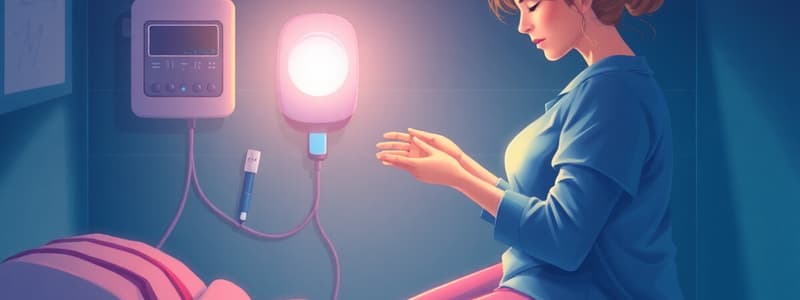Podcast
Questions and Answers
Which urinary characteristic is most indicative of a urinary tract infection (UTI)?
Which urinary characteristic is most indicative of a urinary tract infection (UTI)?
- Clear and pale yellow color
- Dark amber color
- Cloudy appearance with a foul odor (correct)
- Increased urine volume
Which type of urinary incontinence is caused by weak pelvic floor muscles?
Which type of urinary incontinence is caused by weak pelvic floor muscles?
- Stress incontinence (correct)
- Urge incontinence
- Overflow incontinence
- Functional incontinence
Which intervention is most appropriate for a patient with functional incontinence?
Which intervention is most appropriate for a patient with functional incontinence?
- Prescribing antibiotics
- Teaching pelvic floor exercises
- Implementing a scheduled toileting program (correct)
- Increasing fluid intake before bedtime
When collecting a clean-catch urine sample, which action is most important?
When collecting a clean-catch urine sample, which action is most important?
A patient with a urinary catheter develops a fever and cloudy urine. What is the priority nursing action?
A patient with a urinary catheter develops a fever and cloudy urine. What is the priority nursing action?
Which dietary modification helps reduce the risk of recurrent urinary tract infections?
Which dietary modification helps reduce the risk of recurrent urinary tract infections?
A post-surgical patient has not voided for 8 hours. What is the nurse's first action?
A post-surgical patient has not voided for 8 hours. What is the nurse's first action?
A patient with kidney disease is advised to limit which dietary component?
A patient with kidney disease is advised to limit which dietary component?
What is a primary prevention strategy for urinary incontinence?
What is a primary prevention strategy for urinary incontinence?
Which nursing action reduces the risk of catheter-associated urinary tract infections (CAUTI)?
Which nursing action reduces the risk of catheter-associated urinary tract infections (CAUTI)?
A patient with urge incontinence is prescribed an anticholinergic medication. What is a common side effect?
A patient with urge incontinence is prescribed an anticholinergic medication. What is a common side effect?
Which symptom is most concerning for a patient with a urinary catheter?
Which symptom is most concerning for a patient with a urinary catheter?
What is an appropriate intervention for a patient experiencing nocturia?
What is an appropriate intervention for a patient experiencing nocturia?
What is the correct way to obtain a sterile urine sample from an indwelling catheter?
What is the correct way to obtain a sterile urine sample from an indwelling catheter?
A patient is experiencing difficulty initiating urination after surgery. What is the best nursing intervention?
A patient is experiencing difficulty initiating urination after surgery. What is the best nursing intervention?
Flashcards
UTI Urine Signs
UTI Urine Signs
Cloudy urine with a foul odor, suggesting the presence of bacteria and infection.
Stress Incontinence
Stress Incontinence
Incontinence due to weakened pelvic floor muscles, leading to urine leakage during activities like coughing or sneezing.
Functional Incontinence Intervention
Functional Incontinence Intervention
Implementing a scheduled toileting program to prevent accidents, addressing physical or cognitive impairments.
Clean-Catch Urine Sample
Clean-Catch Urine Sample
Signup and view all the flashcards
Fever, Cloudy Urine, and Catheter
Fever, Cloudy Urine, and Catheter
Signup and view all the flashcards
Cranberry Juice
Cranberry Juice
Signup and view all the flashcards
Post-Surgery, No Void
Post-Surgery, No Void
Signup and view all the flashcards
Kidney Disease Diet
Kidney Disease Diet
Signup and view all the flashcards
Preventative Incontinence Strategy
Preventative Incontinence Strategy
Signup and view all the flashcards
Catheter Bag Below Bladder
Catheter Bag Below Bladder
Signup and view all the flashcards
Study Notes
- These notes refer to the Fundamentals of Nursing (Potter & Perry, 11th Edition), focusing on urinary elimination
Urinary Tract Infections
- Cloudy urine with a foul odor is a common sign.
- Dark amber urine indicates dehydration, not a UTI.
Urinary Incontinence
- Stress incontinence is caused by weakened pelvic floor muscles, leading to leakage when coughing or sneezing.
- Implementing a scheduled toileting program is most appropriate for functional incontinence which is due to physical or cognitive impairment.
- Scheduled toileting helps prevent accidents.
- Regular Kegel exercises can strengthen pelvic floor muscles, preventing incontinence.
Clean-Catch Urine Samples
- Allow the first urine to pass before collecting the sample.
- The first part of the urine flushes bacteria from the urethra, ensuring a cleaner midstream sample.
Urinary Catheters
- A fever and cloudy urine in a patient with a urinary catheter suggests a UTI.
- Collect a urine specimen for culture to confirm infection and guide treatment.
- Prevent catheter-associated urinary tract infections (CAUTI) by keeping the drainage bag below bladder level.
- This prevents urine backflow, reducing infection risk.
- Fever and flank pain in a patient with a urinary catheter suggests a kidney infection (pyelonephritis).
- This condition requires immediate attention.
- Obtain a sterile urine sample from an indwelling catheter using a sterile syringe to withdraw urine from the catheter port.
- This method maintains sterility and provides an uncontaminated sample.
Diet and Urinary Health
- Drinking cranberry juice can reduce the risk of recurrent UTIs.
- Cranberry juice contains compounds that prevent bacteria from adhering to the bladder wall.
- Patients with kidney disease should limit protein intake, as excess protein increases kidney workload, worsening kidney disease.
Post-Surgical Urinary Retention
- Perform a bladder scan as the nurse's first action when a post-surgical patient has not voided for 8 hours.
- A bladder scan determines if there is urine retention before taking further action.
Nocturia
- Limit fluid intake in the evening to reduce nighttime urination frequency.
Difficulty Initiating Urination
- Encourage the patient to use a warm bedpan to relax the urinary sphincter and promote voiding naturally.
Medications for Urge Incontinence
- Anticholinergic medications reduce bladder spasms but can cause dry mouth.
Studying That Suits You
Use AI to generate personalized quizzes and flashcards to suit your learning preferences.



